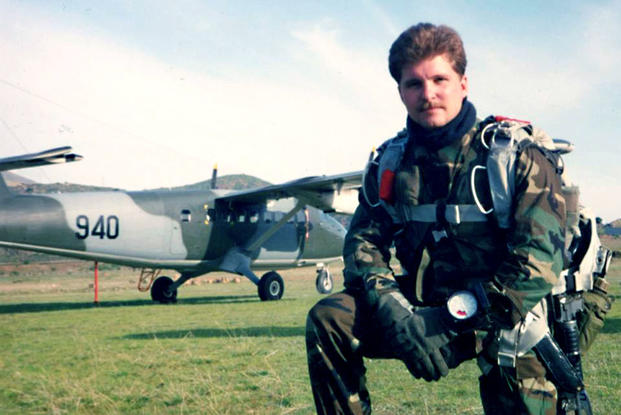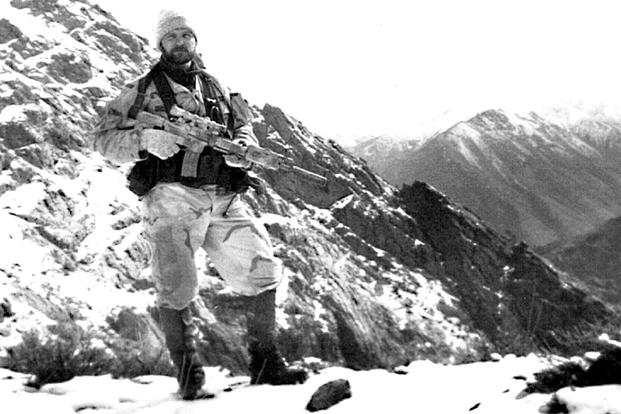Tech. Sgt. John Chapman ran out of a bunker on the Takur Ghar mountaintop for the second time, intentionally risking fire from heavily armed enemy fighters.
Shot several times already, Chapman attempted to halt the al-Qaida forces' assault on an incoming MH-47 Chinook helicopter carrying U.S. special operators.
He no longer had the cover of night, and exposed himself to the enemy as he ran. Dashing out to the ridge line in five-foot-deep snow, Chapman fired at the enemy fighters who were loading rocket-propelled grenades, helping additional American forces to enter the landing zone.
It would be his final bold act before two shots from a large-caliber machine gun cut through his torso, one destroying his aorta and killing him instantly.
But this, Chapman's final fight, occurred well after the special tactics airman had already been presumed dead.
Related content:
- Stop Infighting Around SEAL's Medal of Honor, Awards Expert Says
- AF Cross Recipient: 'Remarkable' Fellow Airman Up for Medal of Honor
- Meet the Airmen Who Will Get Upgraded Valor Medals
A 30-month investigation involving eyewitness testimony from nearby Army and Air Force service members and drone targeteers, intelligence reports and aircraft video feed proved that Chapman not only lived after he was initially hit and knocked unconscious early in the mission, but that he at one point engaged the enemy in hand-to-hand combat, fighting for about 70 harrowing minutes on the ground alone. This week, officials who investigated the circumstances surrounding his death spoke publicly for the first time about their findings.
Chapman, a combat controller assigned to the 24th Special Tactics Squadron, will posthumously receive the Medal of Honor, an upgrade of his Air Force Cross, for his actions on March 4, 2002, during a ceremony at the White House on Wednesday. He will become the first U.S. airman to receive the military's highest award since the Vietnam War.
"John was the only American that was alive on [that] mountain top, and there was somebody fighting for an hour," said an Air Force special tactics officer who was part of the investigation team.
Speaking on background during a briefing at the Pentagon on Thursday, the officer explained how the Air Force Special Operations investigative team and the Pentagon concluded that Chapman had lived and continued to fight after his presumed death.
"When you watch [these videos], heroism jumps right off the page at you," the officer said. "It chokes you up, and it makes you realize the incredible sacrifice."
He added, "You don't have to do 30 months of analysis to see that."
In all, Chapman sustained nine wounds, seven of which were nonfatal, according to his autopsy report. A medical examiner concluded he lived and fought through gunshot wounds to his thigh, heel, calf and torso, which pierced his liver. He had a broken nose and other facial wounds, suggesting he engaged in hand-to-hand combat in close quarters. The final fatal shots likely came from a PKM machine gun, officials said.
The Evidence
The night infiltration began March 3. The reconnaissance team aboard the Chinook, call sign Razor 03, was unaware of the hornet's nest of al-Qaida forces they were about to encounter. Their overall mission was to establish a reconnaissance position in the Shah-i-Kot Valley in southeastern Afghanistan.
After the assault began, a Navy SEAL, Petty Officer 1st Class Neil Roberts, fell out of the helicopter, which then crash-landed about four miles away.
Senior Chief Special Warfare Operator Britt K. Slabinski led the SEAL Team 6 unit, known as Mako 30, to which Chapman was assigned back up the ridge on another helicopter, designated as Razor 04. Chapman began calling in airstrikes from AC-130 gunships circling overhead before returning with Slabinski and five other members around 4:27 a.m. local time.
Slabinski, now a retired master chief, was awarded the Medal of Honor in May for his own heroism during the costly battle.
The team's new objective was to rescue Roberts on the mountainside, which would become known as "Roberts Ridge." Roberts did not survive.
Chapman ran ahead of his teammates, taking fire from multiple directions. He dug himself into a World War II-style pillbox that was chest-deep and hardened, designated as Bunker 01, officials said. He was 10 meters from a second bunker, but left cover to engage the al-Qaida forces.
At 4:42 a.m., U.S. forces with night-vision goggles observed Chapman falling in battle.
Statements from a nearby Army and Air Force reconnaissance team helped investigators prove that a U.S. service member was on the ridge alone, fighting from a bunker position -- Bunker 01.
The second, five-member reconnaissance team was three miles away, listening to Chapman's radio calls.
"I am absolutely positive [it] was John's voice. I have no doubt whatsoever," said one unnamed witness quoted in the months-long investigation, as cited by the Air Force.
"They saw somebody fighting against the enemy from that bunker position for an extended period of time," the special tactics officer said. "They heard the enemy talking about the American on the mountaintop … And the enemy was talking excitedly -- 'An American! An American! An American!' -- and they were actually planning their assault."
Meanwhile, another special tactics airman on the same radio frequency heard Chapman transmitting his call sign -- MAKO 30C.
Two AC-130 gunships, dubbed "Grim 33" and "Grim 32," were circling overhead alongside an MQ-1 Predator drone. The three were capturing different angles of the firefight below, although gaps in coverage existed for technical reasons or repositioning.
Grim 32 used a low-light TV sensor that could see various infrared markers, such as reflective tape on Chapman's body armor as well as strobes from his scope.
"I continued to observe glint tape, strobe lights, muzzle flashes, and [Infrared Illuminator] laser movement after [4:42] from Bunker 1," one AC-130 crew member said in his testimony.
The AC-130 pilots and navigator continued to reference Chapman's position, but the gunships needed to leave the airspace as they had expended their fuel and the enemy could see them overhead.
By overlapping the AC-130 feed and eyewitness testimony alongside the MQ-1 drone feed and the reconnaissance team's audio observation, "we took seven different subject matter experts that all looked at this independently from an intel perspective and then layered those conclusions in," the special tactics officer said.
Additionally, the National Geospatial Agency worked with the Air Force to survey the terrain to measure correct distances, height and trajectory of the firefight.
The videos and testimony substantiated what Air Force officials had believed all along, providing the additional clarity needed to piece together the series of events.
"No one thing would tell [Chapman's] story in its totality. It was bits and pieces combined," the special tactics officer said.
The Final Fight
The mission was part of Operation Anaconda, a large-scale attempt to clear the Shah-i-Kot Valley of al-Qaida forces. Chapman died after fighting off al-Qaida forces for roughly two hours, but his efforts allowed the special ops teams that followed to advance their position on the mountainside.
Along with Chapman and Roberts, Senior Airman Jason Cunningham, Army Sgt. Bradley Crose, Army Sgt. Phillip Svitak, Army Spc. Marc Anderson and Army Cpl. Matthew Commons also died during the mission.
Defense Secretary Jim Mattis made the recommendation to upgrade Chapman's Air Force Cross earlier this year. Air Force Secretary Heather Wilson and then-acting Defense Secretary Robert Work were also involved in the recommendation process as the investigation advanced.
The review of Chapman's award and actions was part of the 2016 Defense Department push to audit more than 1,100 post-9/11 valor citations to determine if they warrant a higher award such as the Medal of Honor.
Even as rumors of Chapman's upgrade remained unconfirmed for months, officials lauded his efforts.
"I think John Chapman is deserving of any honor that is bestowed upon him," Wilson told Military.com in May. "If that happens, I think it will be an important day in the Air Force and for his family."
-- Oriana Pawlyk can be reached at oriana.pawlyk@military.com. Follow her on Twitter at @Oriana0214.














